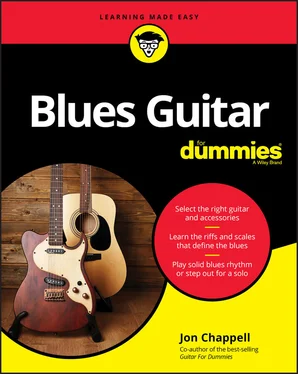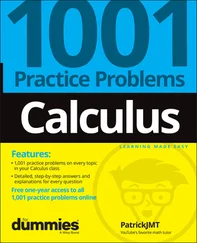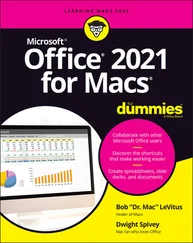8 Chapter 8FIGURE 8-1: Alternate picking on the open high-E string in straight eighth-note...FIGURE 8-2: Alternate picking on the second string in swing eighths.FIGURE 8-3: Alternate picking on the third string with left-hand fretting.FIGURE 8-4: Alternate picking with notes on all six strings.FIGURE 8-5: The notes of the E minor pentatonic scale on the guitar neck.FIGURE 8-6: The ascending E minor pentatonic scale.FIGURE 8-7: A 12-bar blues with an E minor pentatonic lead over it.FIGURE 8-8: The E blues scale.FIGURE 8-9: The E blues scale used to solo over a 12-bar blues.FIGURE 8-10: The major third added to the blues scale.FIGURE 8-11: The major sixth sweet note added to the blues scale.
9 Chapter 9FIGURE 9-1: The left hand is ready to play in fifth position.FIGURE 9-2: The A minor pentatonic scale at the fifth fret.FIGURE 9-3: A passage that uses the descending fifth-position A minor pentatoni...FIGURE 9-4: A passage in fifth-position A blues.FIGURE 9-5: Four notes in the eighth position A minor pentatonic.FIGURE 9-6: A lick in eighth position using the high blue note on the 11th fret...FIGURE 9-7: Four notes in thirdposition A minor pentatonic.FIGURE 9-8: Shifting from fifth to eighth position and from third to fifth posi...FIGURE 9-9: A slide that facilitates a shift from fifth to eighth position.FIGURE 9-10: The seventh and second positions of the A minor pentatonic scale.FIGURE 9-11: The two positions above the home and upper extension.FIGURE 9-12: The five positions of the pentatonic scale.FIGURE 9-13: A passage with shifts that take you in and out of multiple positio...FIGURE 9-14: A sweet-note pattern with a familiar fingering pattern.FIGURE 9-15: A table showing the 12 keys and their pentatonic scale patterns.
10 Chapter 10FIGURE 10-1: A call-and-response exchange can benefit from a contrast in dynami...FIGURE 10-2: Accented notes are struck harder than the surrounding notes.FIGURE 10-3: Muted notes interrupted by occasional accented notes.FIGURE 10-4: Slides into and out of individual notes.FIGURE 10-5: A passage with rhythmic slides between notes.FIGURE 10-6: Three types of hammer-ons.FIGURE 10-7: A lick using various hammer-ons.FIGURE 10-8: Three types of pull-offs.FIGURE 10-9: Pull-off licks — in isolation and with hammer-ons.FIGURE 10-10: A whole note with vibrato.FIGURE 10-11: Two types of bends on the third string.FIGURE 10-12: Bending in rhythm.FIGURE 10-13: Two bend and releases.FIGURE 10-14: Two pre-bend and release phrases.FIGURE 10-15: “Express Yourself Blues” uses a variety of expressive techniques.
11 Chapter 11FIGURE 11-1: A 12-bar blues in the Delta blues style.FIGURE 11-2: A 12-bar blues in E with variations.FIGURE 11-3: A lick in the key of A in the style of Robert Johnson.FIGURE 11-4: A 12-bar blues in the style of Robert Johnson.FIGURE 11-5: A bouncy Piedmont passage.FIGURE 11-6: A ragtime chord progression with bass runs.FIGURE 11-7: Country blues with a melody on top of an alternating bass.FIGURE 11-8: A single-note ragtime tag in C.FIGURE 11-9: A deluxe ragtime tag that uses chords, an arpeggio, and single not...FIGURE 11-10: A rockabilly progression with a hard-driving alternating bass.FIGURE 11-11: A slide lick in standard tuning.FIGURE 11-12: A standard-tuning slide lick in the style of “Dust My Broom.”FIGURE 11-13: A slide lick in open E.FIGURE 11-14: A slide lick in open G.
12 Chapter 12FIGURE 12-1: A slow blues in the style of T-Bone Walker.FIGURE 12-2: A passage in the style of Muddy Waters.FIGURE 12-3: A lick in the style of Elmore James’s “Dust My Broom.”FIGURE 12-4: A single-note lick in the style of Otis Rush.FIGURE 12-5: A passage in the style of guitar great Buddy Guy.FIGURE 12-6: A classic Texas shuffle.FIGURE 12-7: A string-bending passage in the style of Albert King.FIGURE 12-8: The blues lead style and hallmark vibrato of B.B. King.FIGURE 12-9: A lick in the infectious, melodic style of Freddie King.FIGURE 12-10: Robert Cray’s tasteful and economical lead approach.FIGURE 12-11: An open-A slide solo in the style of Bonnie Raitt.
13 Chapter 13FIGURE 13-1: A I-IV-V progression in the Chuck Berry style.FIGURE 13-2: Fiery string bends and flawless technique are hallmarks of Eric Cl...FIGURE 13-3: Hendrix’s brand of “psychedelic blues.”FIGURE 13-4: A solo in the style of Jimmy Page.FIGURE 13-5: A slide riff in the style of the great Duane Allman.FIGURE 13-6: A line similar to Johnny Winter’s classic approach to a blues solo...FIGURE 13-7: Smoldering riffs and edge-of-the-pick harmonics equal a classic Gi...FIGURE 13-8: Stevie Ray Vaughan often combined chord vamps with his leads.
14 Chapter 14FIGURE 14-1: Sperzel’s high-quality tuning machines.FIGURE 14-2: The Wilkinson bridge.FIGURE 14-3: Seymour Duncan’s high-quality third-party pickups.FIGURE 14-4: The Gibson Les Paul (left) and Fender Stratocaster (right).
15 Chapter 15FIGURE 15-1: A typical practice amp.FIGURE 15-2: The Fender Twin amp.FIGURE 15-3: The Marshall Super Lead 100 amp.FIGURE 15-4: Studio players sometimes use a rack system like this one.FIGURE 15-5: The preamp section of an amp.FIGURE 15-6: The tone section of an amp.FIGURE 15-7: An amp’s effects section.FIGURE 15-8: An amp with a footswitch-activated boost.FIGURE 15-9: A tube amp.FIGURE 15-10: A hybrid amp.FIGURE 15-11: The Line 6 Flextone series of amps uses digital-modeling technolo...FIGURE 15-12: The Fender Bassman amp.FIGURE 15-13: The Marshall JTM 45.FIGURE 15-14: The Vox AC30.FIGURE 15-15: The Mesa/ Boogie Mark IIc+.FIGURE 15-16: A collection of distortion devices.FIGURE 15-17: An outboard effect offers more variety and control.FIGURE 15-18: The stomp box solution.FIGURE 15-19: The Digi-Tech GNX1.FIGURE 15-20: The Line 6 Pod XT.FIGURE 15-21: The Line 6 Pod Pro.
16 Chapter 16FIGURE 16-1: Three tools that make string-changing and adjustments a cinch.FIGURE 16-2: Kinking the string in the proper direction.FIGURE 16-3: Wrapping the strings in the proper direction.FIGURE 16-4: Coiling the string on the post.FIGURE 16-5: Clipping the string end close to the post.FIGURE 16-6: Pulling on the string to stretch it out after it’s tuned up.FIGURE 16-7: Kinking the string in the proper direction for inline and split tu...FIGURE 16-8: Wrapping the strings in the proper direction.FIGURE 16-9: Coiling the string on the post.FIGURE 16-10: Pulling on the string after it’s tuned up to get the “stretch” ou...
17 Appendix AFIGURE A-1: Music for “Shine On Harvest Moon.”
1 Cover
2 Table of Contents
3 Begin Reading
1 iii
2 iv
3 1
4 2
5 3
6 4
7 5
8 6
9 7
10 8
11 9
12 10
13 11
14 12
15 13
16 14
17 15
18 16
19 17
20 18
21 19
22 20
23 21
24 22
25 23
26 24
27 25
28 26
29 27
30 28
31 29
32 30
33 31
34 32
35 33
36 34
37 35
38 36
39 37
40 39
41 40
42 41
43 42
44 43
45 44
46 45
47 46
48 47
49 48
50 49
51 50
52 51
53 52
54 53
55 54
56 55
57 56
58 57
59 58
60 59
61 60
62 61
63 62
64 63
65 64
66 65
67 66
68 67
69 68
70 69
71 71
72 72
73 73
74 74
75 75
76 76
77 77
78 78
79 79
80 80
81 81
82 82
83 83
84 84
85 85
86 86
87 87
88 88
89 89
90 90
91 91
92 92
93 93
94 94
95 95
96 96
97 97
98 98
99 99
100 100
101 101
102 102
103 103
104 104
105 105
106 106
107 107
108 108
109 109
110 110
Читать дальше












